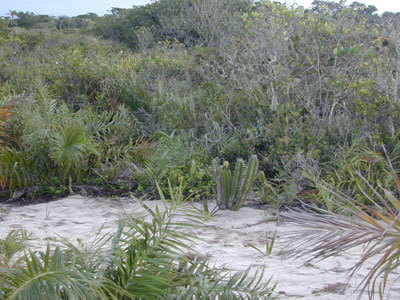 |
BIOL 4120 Principles of Ecology Phil Ganter 320 Harned Hall 963-5782 |
The coastal
dune forest above represents a distinct plant community |
|
Lecture 16 Communities - Structure and Dynamics
Back to:
 |
BIOL 4120 Principles of Ecology Phil Ganter 320 Harned Hall 963-5782 |
The coastal
dune forest above represents a distinct plant community |
|
Lecture 16 Communities - Structure and Dynamics
Back to:
Overview - Link to Course Objectives
Community Definition (16 Intro and section 16.9)
Diversity - Richness and Evenness (16.1)
How are we to compare two communities?
| Fish species from three lakes | |||
| number per species of fish | |||
| Species | North America 1 |
North America 2 |
Argentina |
A |
92 |
||
B |
2 |
||
C |
2 |
25 |
|
D |
2 |
25 |
|
E |
2 |
25 |
|
F |
25 |
||
G |
80 |
||
H |
4 |
||
I |
4 |
||
J |
4 |
||
K |
4 |
||
L |
4 |
||
- Not so easy to decide is it?
- Must include both a Species Richness component and a Species Evenness component
- There is no one way to measure diversity, so we will look at more than one
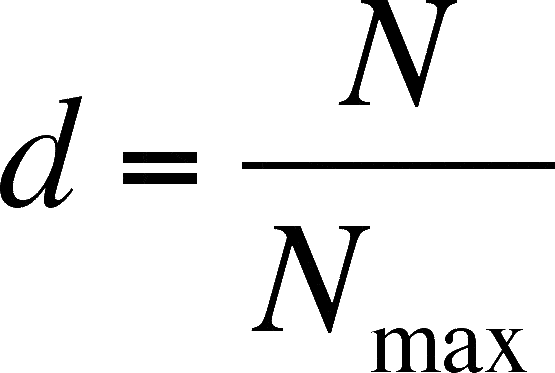
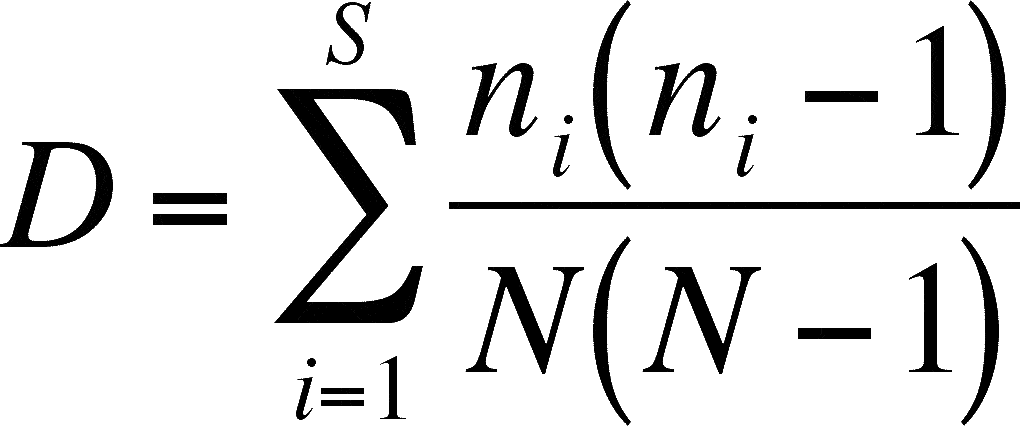
- Notice that D will get smaller as the diversity of the community increases (if you keep N constant and increase the number of species, each ni must be smaller, on average, and so the numerators get smaller).
- Simpson's index is normally expressed as 1/D so that the index will increase as diversity increases
- Simpson's index uses information from each species, unlike Berger Parker, and so it is in some ways more accurate, but it is very insensitive (unchanging) to the addition of rare species to the sample
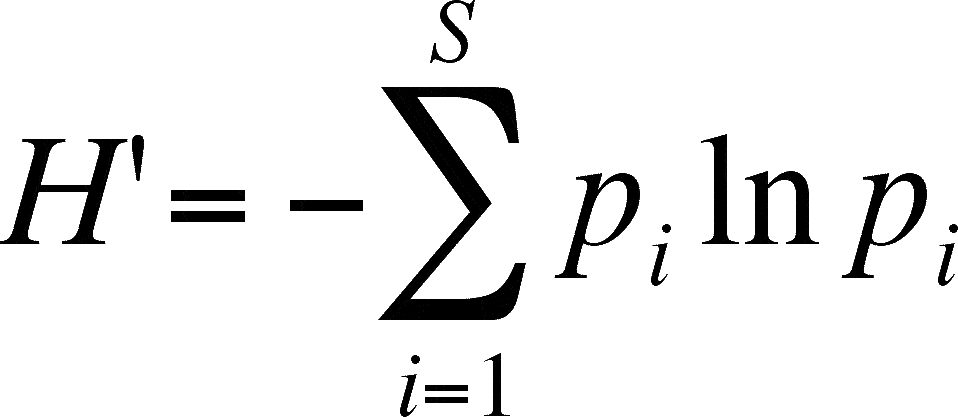
- the negative out front is needed to offset the negative you get when you take the natural log of pi (since pi is a fraction, its log is negative)
- as more species are included, the average pi gets smaller and so its log get s more negative and the total value of the index increases
- This is a useful measure because one can calculate evenness using it.
- For any given sample size containing (N) containing S species, the value of H' will change when evenness changes. The maximum H' value (Hmax), without adding individuals or species, is attained when the numbers of individuals of every species is equal (here, the proportion would be 1/S). Evenness (E) is then the ratio of the actual H' value to the maximum value (and thus it ranges from 0 to 1)
- In this index, both species richness and evenness matter.
- When the number of species increases, H' increases.
- When one species dominates (and evenness decreases), H' decreases.
- The Shannon index is dependent on the assumption that the sample used to generate it is a random sample of the community
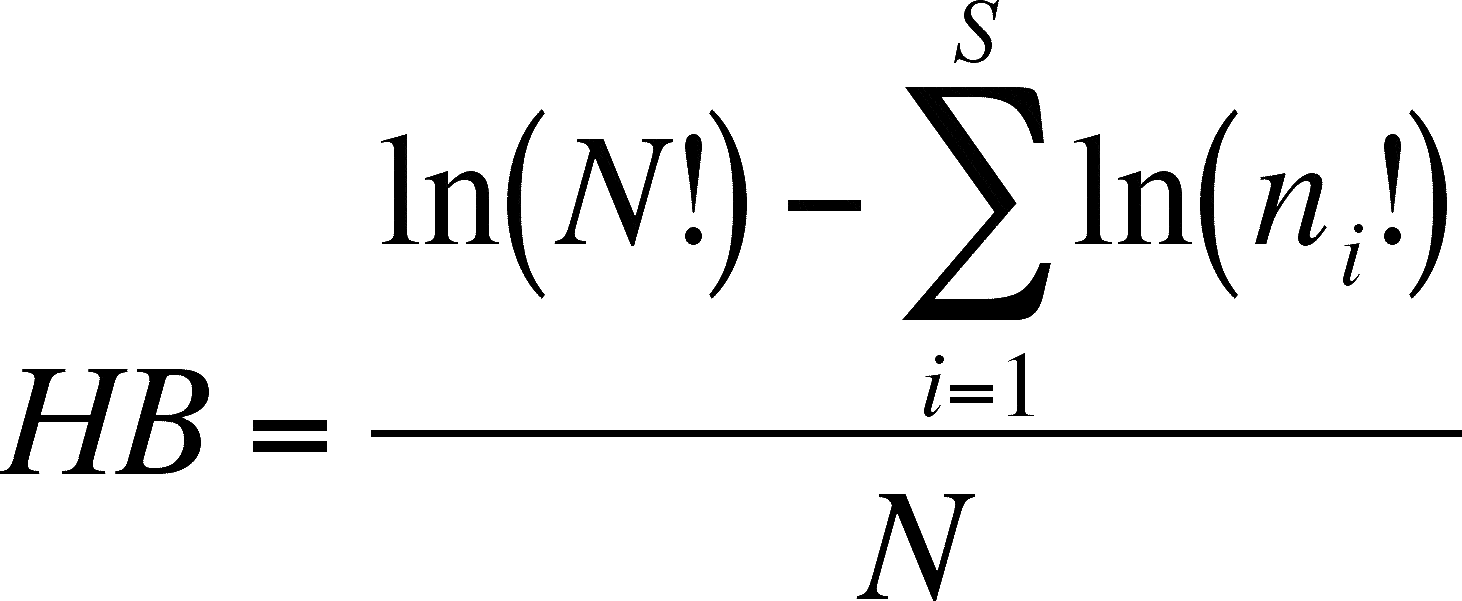
Diversity Factors (17.6 and 17.7)
Environmental Heterogeneity
Environmental Quality
Interactions among species within a community
- Species are not distributed evenly and a few species may contribute most of the individuals (or the biomass, where individual size varies greatly among species).
- Dominance is not strictly the converse of diversity, for a community can be diverse and have dominant species if there are many rare species present.
- Keystone species are those with a disproportionate effect on the community.
- The impact may come through:
- competition - some species may be able to exclude others, so that when the best competitor is removed, several species can invade
- predation or herbivory - removal of a predator or herbivore that feeds on the best competitor in a community may allow the that competitor to expand its population size so that it competitively excludes other species.
- keystone species may be prey as well as predators
- loss of a keystone prey species results in loss of many predatory species
- structure - some species may alter the environment in a way that creates opportunity of other species
- trees become habitat for many animals
- corals build reefs that become habitat for many algae and animals
- Beavers are a classic keystone species that act as ecosystem engineers
- Alter the environment by building their homes by making ponds
- hundreds of species in the ponds rely on the presence of the beavers
- They may be dominant species but it is not necessary that they be dominant
- Food Webs are based on which species eat other species.
- This may be directly (predation, herbivory, parasitism) or after the food item is dead (detritivory)
- Simple interactions are Food Chains but more realistic maps of interactions are Food Webs
- Remember that this view of a community is based on feeding and that there are other relationships between organisms that are not part of a food web
- habitat formation, competition, amensalism, commensalism are examples of non-food web interactions
- pollination when no food is consumed is another
- Connectance: - The Math of Food Webs
- Trophic link - relationship between a pair of species indicating that one eats the other
- Connectance - the ratio of actual links to the total number of links possible for an ecosystem
- Interest in this comes from the idea of stability
- Some believe that interconnected systems are more stable
- Others believe that as interconnectivity increases, instability increases
- Connectance = number of links/total number of links possible
- If n = the number of species in the web, the total number of links possible = (n[n-1])/2
- Low ratio means that species eat relatively few other species and the food web is simpler
- High ratio means that species eat lots of other species and the food web is complex
- Linkage density (d) - average number of links per species
- d = total number of links/number of species
- a second way to look at food web complexity (only partially correlated with connectance)
- as you add species, if d remains the same, then connectance will fall
- There is no agreement about how connectance and linkage density change with an increase in the number of species
- Generalizations about food webs
- Omnivory is rare and links usually do not form circles
- Because this is so, we can define Food Chain Length as the average number of links between producer and tertiary consumer in a food web
- Food chains lengths tend to be short
- Food chain length does not correlate well with total productivity of the system
- Food chain lengths are shortened by:
- Island size (smaller islands have shorter food chains)
- Human disturbance (disturbed habitats have shorter chains)
- Habitat complexity (longer in complex habitats)
- Chains are shorter in two-dimensional habitats (grasslands, organisms attached to hard substrates) than three dimensions (forests)
- Objections to the generalizations
- We almost always have incomplete information on food webs
- Often we aggregate (lump) species that look similar without knowing if their diets are really similar
- The theory does not make any adjustment for the importance of a species in another species diet
- If most of the species in a diet are just occasional snacks, the food web is actually simpler than the map of trophic links indicates
- Limiting nutrients are not usually known
- Minor links can be critical if they supply limiting nutrients
Trophic Cascades When the size of a population is affected by the size of populations on trophic levels more than one step removed from it, then these interactions are called a trophic cascade
- can result from both bottom-up and top-down effects (see examples above)
- one general hypothesis about communities based on trophic cascades is the
- Ecosystem Exploitation Hypothesis combines elements of both top-down and bottom-up regulation
- most important variable is the total productivity of the primary producers
- when primary productivity is low, there is not enough production of biomass to sustain large herbivore populations
- as primary productivity increases, herbivore populations increase
- thus most of the increased production winds up as herbivore biomass, not primary producer biomass
- as primary productivity increases still more eventually the herbivore populations are large enough to support prey populations
- predators depress herbivore population sized
- fewer herbivores increases biomass of primary producers
Guilds (16.5) are groups of species that all utilize a resource in the same way so that their interactions are characterized by the effect of the shared resource
- simplifies the approach to studying the community
- often a trophic interaction that characterized a guild
- all seed-eating birds in a forest
- all insects that feed on oak by mining its leaves
- all parasites that parasitize parasitoids in an area (these are called hyperparasites since they parasitize parasites)
Physical Structure of Communities (combine 16.6 and 16.7 and 16.8)
Community, Assemblage, Species Richness, Dominance Index, Berger and Parker index, Simpson's index, Information Index, Shannon index, Evenness, Brillouin Index, Environmental Heterogeneity, Size Symmetry, Direct Interaction, Diffuse Interaction, Indirect interactions, Keystone Predation, Apparent Competition, Dominance, Keystone Species, Ecosystem Engineer, Food Webs, Trophic Link, Connectance, Linkage Density, Trophic Structure, Primary Producer, Primary Consumer, Secondary consumer, Trophic Pyramid, Decomposer, Transformers, Top-down effect, Bottom-up effect, Trophic Cascade, Ecosystem Exploitation Hypothesis, Guild, Canopy, Understory, Herb Zone, Forest Floor, Zonation, Edge effect
Last updated March 9, 2007